Perry, Perry On The Wall … Who’s the Biggest Brother Of All?

For reasons not quite clear, Perry Anderson does a hatchet job on India, using selective data on police, prisons, surveillance. Better data leads to conclusions different from Perry Anderson’s.
|
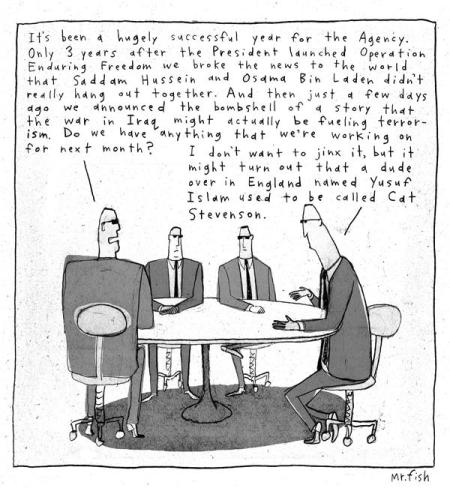
After millions of agents and billions of dollaqrs … | Cartoon By Dwayne Booth, Mr. Fish – 9/25/2006 12:00:00 AM; source & courtesy – cagle.com
Changing spots
Employed with an American university (UCLA) for 30-years, Perry Anderson, a Marxist professor of British origin, has been completely taken up with India.
Published in July was his first-post, Gandhi Centre Stage (LRB 5 July 2012), and his next post was After Nehru (LRB 2 August 2012). Between these two posts, Perry Anderson has come up with some 33,000 words.
Enough material for a 100-page book.
Follow the money
Cleverly mixed with his reluctant admissions of truths, half-untruths, and complete lies, it is unclear why he has taken up such a project.
Why India?
As a Marxist, wouldn’t Communist China or Socialist Russia be an easier – and more interesting objects for Perry Anderson’s affections? For me, Socialist Germany is the most interesting country-study one can do today.
As a Marxist, it is again rather puzzling that Perry Anderson has so much thinly-veiled pride for colonial-imperial Britain – and such antipathy towards an earnest, wannabe-socialist India.
This is the third of the posts for a 2ndlook at some issues that Perry Anderson raises in his posts.

Perry, Perry on the wall? Should he West not be worried miore about itself? | Justice Is Suspicious Character in Sanford Florida; By RJ Matson, The St. Louis Post Dispatch – 4/17/2012 12:00:00 AM
Big Brother
Perry Anderson makes an interesting point on India.
the role and character of the army, the Central Reserve Police Force, Border Security Force, Central Industrial Security Force, Home Guards, let alone the clandestine powers and activities of the Intelligence Bureau (a vast military, paramilitary and surveillance complex, totalling upwards of two million operatives), receive even passing mention in most of the literature on the world’s largest democracy.
Perry Anderson does not provide any comparative aggregates, for any other country. Either at a gross level or on a per-capita basis.
Except India.
Perry Anderson expects us to accept his surmise at face-value – without further examination, data or evidence? By not providing comparative data Perry Anderson attempts to imply that the numbers he provides for India is a large number – and other comparable countries are lower.
Which is completely untrue!
But, not to worry!
Cross country statistics are hard to come by. Takes some searching, but on some country pairs, some data is available.
For instance, India and USA.
Increasing data on this subject have been available to 2ndlook readers for the last 5 years.
Does Perry Anderson’s India numbers include army, police, para-military, industrial security forces?
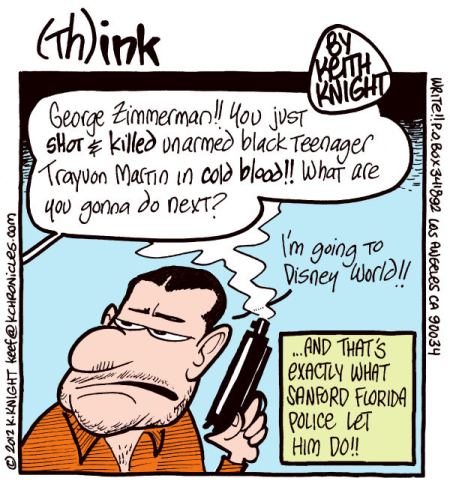
150 years after Emancipation; 50 years after civil rights movement, we are left with this | Disney World By Keith Knight, PoliticalCartoons.com – 3/27/2012 12:00:00 AM
Half Untruths
Let us check out some data to see how valid Perry Anderson’s claim is about India’s ‘vast military, paramilitary and surveillance complex, totalling upwards of two million operatives’.
Before going further let us look at some data on Indian police & military size.
- CRPF – 3 lakhs
- BSF – 2.5 lakhs
- Railway Protection Force – 0.65 lakh
- CISF – 0.25 lakh
- Civilian Police – 10 lakhs
- Total Police – 16 lakhs (total of 1-5 items).
- Indian Armed Forces – 13.25 lakhs
- State Total – 30 lakhs
- Private Security Total – 30 lakhs
I wonder from where does Perry pull out the 2-million figure – when the actual is closer to 3 million?
Let us look at USA – the only Western country close to India in terms of size, diversity, population.
US Police & Military
- US Armed Forces – 15 lakhs
- US Civilian Police – 10 lakhs
- US Secret Police – 30 lakhs
- US Industrial Security – 20 lakhs
- Total US Military & Police apparatus – 75 lakhs
Indian population is 120 crores and the US population is 31 crores. The American military-police apparatus is bigger by 25% for a population, that is a quarter the Indian population.
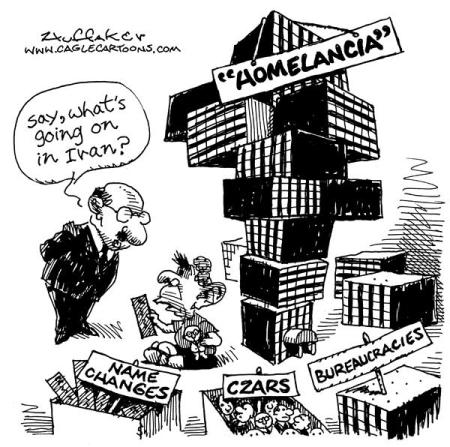
Bigger technology, larger police, more secret policemen. More prison ers, more killings b y the State. | Cartoon titled Intelligence Bureaucracies By Huffaker, Politicalcartoons.com – 5/8/2006 12:00:00 AM
Macro Numbers
US Census Bureau says, 63% of US population, is between the age of 18-65 – numbering 19.5 crores (from 31 crores). US DoJ data release for the year-2011, says the number of people in correctional system (probation, parole or prison) excluding under prosecution, is more than 70 lakhs – mostly from 18-65 years group. That is 70 lakhs people out of 19.5 crores – nearly 4% (3.63% to be exact).
Anyway you look at it, it is more than any other country in the world.
Each year, the US system has to deal with 2.1 crore people in prison, on probation or parole, or being prosecuted. Ranged against 2.1 crore law-breakers are 60 lakhs in the various types of police plus 10 lakhs in judiciary.
This totals to 2.8 crore people who are law-breakers or law enforcers from a working age population of 19.5 crores. With every seventh adult in the business of (il)legal-activity, makes US clearly a leader of the ‘Free’ World.

Bigger technology, larger police, more secret policemen. More prison ers, more killings b y the State. | Cartoon titled Intelligence Bureaucracies By Huffaker, Politicalcartoons.com – 5/8/2006 12:00:00 AM
Custodial Deaths
Perry Anderson then goes onto wite about the excesses of the Indian Police.
Arvind Verma writes that 53,000 people were arrested under the Terrorism and Disruptive Activities Act, of whom just 434 could be convicted seven years later, he underlines some daily realities of Indian democracy: ‘Torture is routinely practised in most police stations and death in police custody is a frequent phenomenon’
Before looking at Indian numbers, let us look at some American numbers.
In the words of the BoJ-Statistics department report, ‘At yearend 2007, federal and state prisons and local jails held just under 2.3 million inmates (2,293,157).’
The US Bureau of Justice reports a total of 32,834 custodial deaths in the USA for 2001-2007 period. This has been broken up into local prisons with 8,097 inmate deaths from a local prison population of 782,595. This data is for local prisons only – which are lower level prisons. State prisons accounted for 21,936 deaths and Federal prisons for 2801 during 2001-2007, totalling 24,737 custodial deaths in State and Federal prisons for the 2001-2007 period.
This does not include arrest-related deaths.
For India, a activista report gave out the statistics.
“Torture in India 2011” states that a total of 14,231 persons i.e. more than four persons per day died in police and judicial custody in India from 2001 to 2010. This includes 1,504 deaths in police custody and 12,727 deaths in judicial custody from 2001-2002 to 2009-2010 as per the cases submitted to the National Human Rights Commission (NHRC).
These deaths reflect only a fraction of the problem with torture and custodial deaths in India as not all the cases of deaths in police and prison custody are reported to the NHRC.
via 14,231 Persons Died In police And Judicial Custody In India From 2001 To 2010 By Suhas Chakma.
A comparison could be made by taking data on a pro-rata basis. Some 8,900 custodial death among 400,000 prisoners in India (2.23%) compared to nearly 33,000 deaths from a prisoner base of 2 million (1.65%).
This means 19 additional deaths each month in India. Does this speak of unspeakable torture and human abuse in a country of 120 crores, with a State policing apparatus that uses nearly 3 million ‘operatives’?
How many of these deaths could be due to pre-existing illnesses? India after all has the largest numbers of people affected by TB, diabetic, cardiac diseases. Prison conditions could easily result in higher mortality due to these illnesses. Poorer healthcare in Indian prisons?
Is this vastly different from mortality rates between general population in India and USA?
UPSA – United Police State of America
Overwhelming data point towards the fact the US is a police State beyond comparison. With
- 7 million people under some kind of correctional supervision – prison, parole or probation.
- With 2 million prisoners
- Some 3 million employees in US secret services (FBI, CIA, NSA, etc).
- 1 million civilian police as per FBI data
- More than 14 million prosecutions yearly (2002), to keep these 1 million police personnel busy. The US prosecutes more people than the next 45 countries for whom data is available.
It is fashionable in the US to moan over how powerful ‘secret police’ has become of late.
But this is not new.
For 48 years, Edgar Hoover headed FBI. No POTUS (President of the US), no GOTUS (Government of the US), no SCOTUS (Supreme Court of the US) could touch him. He had a file on everyone. Including musicians (like John Lennon) to many Hollywood starlets.
No State has taken so much offence against its own citizens as the GOTUS.
Of late, the US Government made more requests to Twitterto reveal confidential information, than all other Governments in the world put together.
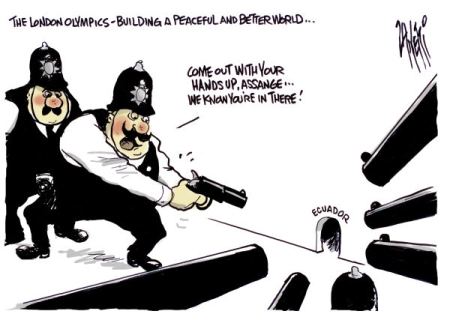
Was the persecution of Julian Assange useful, or essential for any other reason ? | Julian Assange Siege By Paul Zanetti, Australia – 8/16/2012 12:00:00 AM
Police Killing – In India & USPA
Coming to the point about Indian police killing civilians.
First, let us take data for people killed by US-police during line of duty.
Looking for the number of burglaries last year in Devils Lake, N.D.? How about the increase in property crimes in Caribou, Maine? The answers (34 and 23 percent, respectively) are readily available from the FBI.
Want detailed information on how many people were shot by police in the United States last year?
That’s not so easy to find.
The nation’s leading law enforcement agency collects vast amounts of information on crime nationwide, but missing from this clearinghouse are statistics on where, how often, and under what circumstances police use deadly force. In fact, no one anywhere comprehensively tracks the most significant act police can do in the line of duty: take a life.
“We don’t have a mandate to do that,” said William Carr, an FBI spokesman in Washington, D.C. “It would take a request from Congress for us to collect that data.”
Congress, it seems, hasn’t asked.
But let me confess. I am wondering is this is a case running and hiding …
A Pulitzer prize winning investigation by Washington Post, on Washington DC police practices concluded that the
extent and pattern of police shootings have been obscured from public view. Police officials investigate incidents in secret, producing reports that become public only when a judge intercedes. In a small hearing room closed to the public, nine of every 10 shootings are ruled justified by department officials who read the reports filed by investigating officers but generally hear no witnesses.
In the internal records used to track shooting trends, D.C. police undercounted by nearly one-third the number of people they killed from 1994 to 1997, tallying only 29 fatal police shootings. The Post investigation confirmed 43 fatal police shootings in that period. Seven fatal shootings were missing from police shooting trend records, and seven other fatal shootings were mislabeled as nonfatal.
The rise in police shootings in the mid-1990s went largely unnoticed among the top officials charged with policing the police.
“No one said there was a problem with shootings,” said Stephen D. Harlan, former vice chairman of the D.C. financial control board. Former D.C. chief Larry D. Soulsby, who presided over the department from 1995 to 1997, said the rise in shootings “was not a hot topic among police officials.”
Off-duty shootings have added to the total of District police shootings in the 1990s. When shooting incidents peaked in 1995, 36 percent of the shootings occurred while officers were off duty, considerably more than the 17 percent to 22 percent that various studies over the years have found in other large cities. Even more striking, more than half of the District’s 16 fatal shootings in 1995 happened off duty — compared with a national average that ranges from 9 percent to 16 percent, according to a study by the International Association of Chiefs of Police.
Many experts consider off-duty shootings problematic for several reasons: The officers are not readily identifiable; they may have been drinking; and they are usually acting alone without backup officers, making them more vulnerable and fearful.
The lawsuits that often follow off-duty police shootings have been costly to District taxpayers.
It appears that while FBI is not publishing or releasing this data, it is nevertheless available – as this 2008 report reveals.
The number of justifiable homicides committed by police and private citizens has been rising in the past two years to their highest levels in more than a decade, reflecting a shoot-first philosophy in dealing with crime, say law enforcement analysts.
The 391 killings by police that were ruled justifiable in 2007 were the most since 1994, FBI statistics show. The 254 killings by private individuals found to be self-defense were the most since 1997.
Police are justified, the FBI says, when felons are killed while the officer is acting in the line of duty. Rulings on these deaths are usually made by the local police agencies involved.
Some law enforcement analysts say the numbers represent changing attitudes on the streets, where police have felt more threatened by well-armed offenders.
via FBI: Justifiable homicides at highest in more than a decade – USATODAY.com.
What in the USA are called officer-involved shootings, in India are called police-encounters.
But there is marked difference in the way this has been handled.
Indian courts (including the Supreme Court), media, bureaucrats have been monitoring these cases – and passed strictures on some policemen and departments.
Killings of people from minorities (Muslims in India, like the US Blacks) arouses the systems’ ire. In the Sohrabuddin case, a high-ranking politician (Amit Shah) and a high-ranking police-official (DG Vanzara) are being prosecuted. The Batla House shooting continues to to be debated years after the incident. This is only of course, anecdotal evidence. Quantitative data is also given which dilutes Perry Anderson’s critique to nothing.
Meanwhile in the Washington, DC, USA
Three times in the last three years, police have shot fellow officers, killing two and wounding the third. In all three instances, white officers shot black officers in civilian clothes, including a pregnant female officer, after mistaking them for criminals.
India’s National Human Rights Commission (NHRC) has been meticulously compiling data and publishing this data. Media and civil activists have been involved in this. Given below is an extract from a report carried by an American magazine (Time) – which gives indicative data.
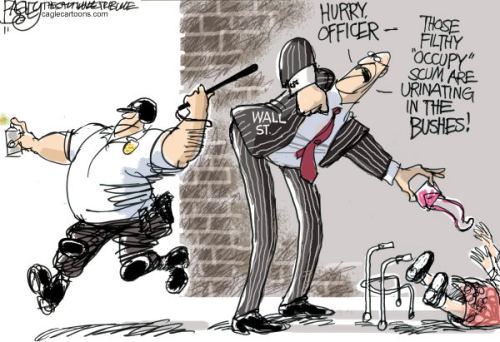
Mirror, mirror on the wall, who ia is worst of them all. | Lawless OWS Hippies By Pat Bagley, Salt Lake Tribune – 10/27/2011 12:00:00 AM
the violence is for real: public records show he has personally gunned down 87 gangsters in the mean streets of India’s film and organized crime capital since 1990. The 41-year-old’s scorecard has made him the country’s deadliest cop ahead of two other inspectors, Praful Bhosle, 46, and Vijay Salaskar, 45, who have clocked scores of 82 and 40, respectively. All three are from Bombay’s elite Criminal Intelligence Unit, which, as Mob crime spiraled out of control in the early 1990s, was tasked with taking down the bad guys, guns blazing if necessary. Few mobsters went quietly: police shot 71 in “encounters” in 1997, 83 in 1999 and 97 in 2001. In all, since records of shoot-outs began in 1982, police have killed 1,200 gangsters in and around Bombay.
The effect on India’s crime capital has been dramatic. From two a week at the height of the violence in the early 1990s, intergang gun battles are down to two a month. Once almighty syndicates are losing scores of men and millions of dollars because of the disruption to their businesses. Arun Gawli, who describes himself as a former Mafia don, sees himself as a virtual prisoner in his own mansion, living behind a phalanx of armed guards, CCTV and four separate locked gates, out of fear of what he calls “police contract killings.” “In a democracy, these sorts of killings are unlawful,” he says. Gawli, 51, claims he has lost a total of 60 associates to encounters in the past decade. “O.K., there were days a while back when I went astray. But this sort of murder campaign is way beyond acceptable.”
That’s a view shared by human-rights groups. Lawyer Seema Gulati even warns that the “growing trend of police killings” is endangering India’s democratic foundations. “They’re just bumping them off,” she says.
Police bosses counter that they are being criticized merely for being better shots than the Mafia. They add that none of the hundreds of complaints alleging staged shoot-outs or executions filed by victims’ relatives or human-rights groups or even a handful of official inquiries has ever led to a conviction for extrajudicial killing. “The allegations of fake encounters are baseless,” says Pradeep Sawant, Bombay’s deputy police commissioner. “It’s not that we always go to kill. Our idea is to arrest the gangsters. We only retaliate if we’re fired upon.”
Many in India argue that there are few alternatives, since the country’s judicial system is tainted by corruption and crippled by backlog. Kanwar Pal Singh Gill, India’s most famous cop for helping put down the Sikh insurgency in Punjab state in the 1990s, is blunt: “Our legal system doesn’t work at all. If there are no legal remedies, there’ll be extralegal ones.”
By and large, this is a compromise the public accepts. “We know the vast majority of encounters are fake,” says Hindustan Times editor Vir Sanghvi. “We do not think that this is a perfect situation, but in common with the rest of the middle class we have come to the regrettable conclusion that there is no real alternative.” For a professional enforcer like Sharma, success isn’t just measured in body bags or reduced gang violence, but invitations to celebrity parties and near unanimous media praise. “I don’t enjoy killing,” says Sharma. “But after we shoot some mobster, his victims look at me like God. That’s the best part of the job.”
via Urban Cowboys – TIME.
Based on official monitoring of such ‘encounters’ an updated Wikipedia entry gives more data.
According to the National Human Rights Commission of India, there were 440 cases of alleged fake encounters in the country during 2002-2007. Most of these happened in the states of Uttar Pradesh (231), Rajasthan (33), Maharashtra (31), Delhi (26), Andhra Pradesh (22) and Uttaranchal (19).[2]
From 2008-09 to June 2011, NHRC recorded 369 cases of alleged fake encounters. By June 2011, NHRC had resolved 98 of these cases, while the rest were pending settlement. The states with high number of cases were Uttar Pradesh (111), Manipur (60), West Bengal (23), Tamil Nadu (15) and Madhya Pradesh (15).[3]
via Encounter killings by police – Wikipedia, the free encyclopedia.
Though officially not published or collated, investigations by civil rights groups reveal indicative data about police officer-involved killings in the US.
The problem of fatal police shootings in America goes beyond a few bad apples. It points to persistent and systemic problems that lead to ongoing tragedies for communities of color. Between 1980 and 2005, close to 9,600 people were killed by police in America — an average of about one fatal shooting every day. However, the real number may be higher due to underreporting by some departments to the federal government. For example, the Los Angeles Police Department responded to a Freedom of Information Act request by claiming there were 79 fatal police shootings from 2000 to 2005. Yet only 38 fatal shootings were reported to the federal government for the same period.
While the precise number may not be clear, it is apparent that fatal shootings are not inevitable. Washington, D.C. had the nation’s highest rate during the 90s. It’s also clear that shootings are not distributed evenly throughout the population. In Chicago, for example, more than two-thirds of the shootings happened in black and Latino neighborhoods, and the majority of the incidents occurred in poor neighborhoods.
African Americans are particularly at risk of being killed by police. Black people were overrepresented among victims in each of America’s 10 largest cities. This contrast was particularly glaring in New York, Las Vegas and San Diego, where the percentage of black people killed was at least double their share of the general population. “There is a crisis of perception where African American males and females take their lives in their hands just walking out the door,” said Delores Jones-Brown, interim director of the Center on Race, Crime and Justice at John Jay College in New York. “There is a notion they will be perceived as armed and dangerous. It’s clear that it’s not a local problem.”
The shootings may be explained in part by implicit bias on the part of police officers, according to research by University of Chicago Professor Joshua Correll. In New York, connecting negative stereotypes with racial identity was considered as a factor in the 1999 fatal shooting of Amadou Diallo and the 2006 shooting of Sean Bell — both of which involved black male victims being killed by more than 40 shots fired by officers.
Another key part of the equation: a disturbing lack of internal accountability from local police departments.
In Chicago, nearly half of the officers sued in those shootings had been sued for previous violations. Most had been sued at least twice. Although being sued does not mean an officer is guilty, multiple lawsuits against the same officer should draw the department’s attention.
Yet little seems to happen to these and other officers accused of killing residents. Chicago’s initial “roundtable” investigations of 85 officers cleared all but one of them — and that officer got a promotion two years later. (Police officials said they did find fault among other officers but could not provide any statistics.)
A similar situation exists in Phoenix, which had the highest rate of fatal police shootings among the nation’s 10 largest cities. Although there were more than 100 incidents of officer-involved shootings in the city during the past five years, and numerous shootings in neighboring jurisdictions, only one shooting in the county has resulted in criminal charges being filed against the officer who fired — and that was for the fatal shooting of a white woman.
This broken system hurts everyone.
Multiple reports and studies seem to converge to an estimate of roughly 400 officer-involved fatalities in USA. The 2008-report extracted above also gives a similar figure. The latest Wikipedia listingof officer-involved fatalities for 2012, of the last 9 months is close to 400. Full year figures will cross 500 – unless there is intervention.
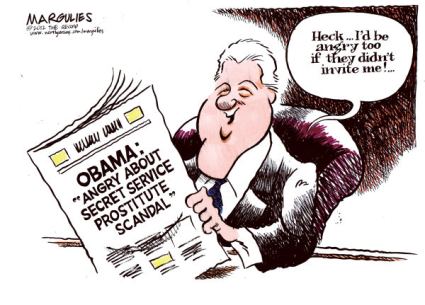
The US Secret Service Colombian prostitute scandal. Secret service agents on the POTUS detail ignored their job – and spent time on hiring prostitutes. | Cartoonist Jimmy Margulies in 2012
So, while in the USA, officer-involved deaths are around 400 per annum. In India the comparable figure is 75-80 ‘encounter’ deaths. Roughly in the same 4:1 to 5:1 prisoners ratio between US and India.
So the major difference in arrest-related deaths is the noise levels. While noise levels seem lower in US, in India these encounter deaths have evoked a significant backlash. Even mobsters like Arun Gawli thinks he can protest against these deaths.
Secret Police
With the biggest secret service in the world, the largest prisoner population, in addition to one of the the largest police forces in the world.
Regarding figures for people employed in pure intelligence work, India has some 25,000 people in the Intelligence Bureau. Compared to 30-lakh employees in US Secret Service. So, Perry-bhau, we are talking of 25,000 intelligence operatives in India – versus US that has 30 lakhs.
The predominant target of the US secret police are the 70 million American males in the 18-60 years of age. Thousands of organisations, controlled by 17 apex American secret service agencies track these 70 million people.
Industrial Security
If Perry Anderson would like to include the CISF, in India’s ‘vast military, paramilitary and surveillance complex’, then would he like to include its Western equivalent – like private security, which has the same function?
A report commissioned by the US-DoJ estimates that the private sector provides about 1 million employees for industrial security. Another million by provided to US defence and government establishments by Defense Industrial Security Clearance Office (DISCO) through contractors. That is a total of two million private security personnel.
Indian private security industry is estimated at Rs.25,000-30,000 crores by value – and about three million by head count.

The elite did manage to drive away the ‘usurpers’. | After the evacuation of OCCUPY WALL STREET By Patrick Chappatte, The International Herald Tribune – 11/21/2011 12:00:00 AM
Anecdotal Evidence
Remember Bradley Manning. Dare I remind you of the another marine Brandon Raub. Probably you don’t have the courage to advise your Government after Obama has signed the NDAA Bill. So, no bail, only jail, if Daddy does not like you.
You got problems at home. Save your ideas and lectures where it is needed most.
Nearly a 100 countries in the world have a population that is lesser than the number of US citizens in prison, on parole or probation, or under prosecution by the State.
Of course! It clicks now.
After all, Britain the mother-country of Anglo-Saxon Bloc, first annihilated the native populations and then populated the entire continent of Australia with such people.
‘A staggering number of laws that sanction the use of coercive powers have been enacted in India,’ Arvind Verma writes. Noting that 53,000 people were arrested under the Terrorism and Disruptive Activities Act, of whom just 434 could be convicted seven years later, he underlines some daily realities of Indian democracy: ‘Torture is routinely practised in most police stations and death in police custody is a frequent phenomenon,’ while – nominally outside the jails themselves – ‘the police practice of getting rid of suspects through staged encounters is unfortunately all too common. Suspects against whom the police are unable to bring substantial evidence or those who are perceived to be dangerous are simply murdered.’ Nor, while the police are at work, have the military been idle. In the 1960s, the army was deployed ‘in aid of the civil power’ some 476 times, and in 1979-80 alone, 64 times; often ‘openly stationed so as to provide a perpetual reminder, and on occasion an actual expression, of the fact that the existing social and political order in India is only to be challenged by its critics at their peril’.
Let us compare again.
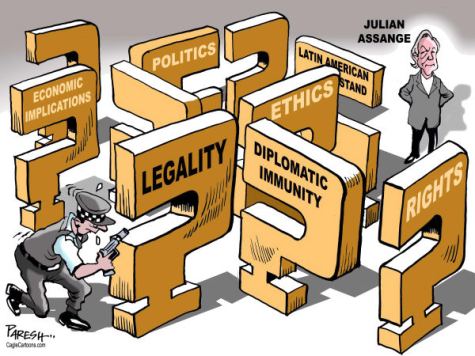
Big talk also means Big Walk. Questions on Assange By Paresh Nath, The Khaleej Times, UAE – 8/28/2012 12:00:00 AM
Behind Bars – Benchmark USA
Under all laws, all statutes, for all reasons, at all stages of prosecution, India has custodial population of 400,000 compared to the US with 2 million. N on -custodial prosecution figures are excluded from these figures.
Without getting technical or delicate, if we include all disappearances, encounter deaths as State Executions, the figure is less than the people executed in the US.
So …
Perry-bhau If our Indian Government wants to foolishly follow the Yumm-Rikan example, we will take care of it. Our Government! Our problem. Our solution. Don’t need no silly mindless, hectoring from you.
But I will limit it to one simple, suggestion. Give your gyaan to your YummRikan Government.
Related Articles
- After Nehru (3quarksdaily.com)
- Retrieving a History: Responding to Perry Anderson on India (3quarksdaily.com)
- The Kashmir Story: A Western Narrative (quicktake.wordpress.com)
- Disposable America (counterpunch.org)
- Ken Macleod on George Orwell, Perry Anderson, Politics, and the English Language (delong.typepad.com)
- The Big Lie About Police Brutality (counterpunch.org)



Very good. If you see the YouTube clip for US series Newsroom Episode 1 opening scene. It’s very good.
Nice analysis, the question that needs to be pondered over is why these american clowns are so hell bent in showing India in a poor light? This is definitely not the first time some random american has come up with his “oh look how sad the people of this turd wurld country live in” drama and I’m pretty sure he won’t be the last.Putting a lid on such empty vessels is the need of the hour. The other interesting fact in such “revealing” and “shocking” reports about Bharat, for the last two centuries is filled with bullshit data, things that cannot be verified by a common man without the access to the information that has been used in the report, as a result most people easily gulp these datas down their throat.
Maya is a especially powerful weapon that asuras use.
Of all the critiques and reviews that I have read on Perry Anderson’s attack, I have not seen a data led refutation. And I think data reveals a lot.
Curiously, YummRika ensures that this data is widely dispersed – and unless you use the right search terms, know exactly what to look for, you will not get the data.
Perry Anderson is a British clown, working in USA.
Writing some 50,000 words is no joke. With academic rigour. Without using clichés. So, a lot of thought has gone into this attack.
I see Perry Anderson’s attack on India as a deliberate action – and not a random piece of writing.
Imagine a 60-year old Marxist attacking a socialist country like India – and bleeding for imperial Britain. For 30-years in UCLA, to suddenly discover his British loyalty?
Look at the British record.
1. In 1860s they used Max Muller to promote Central Asian Invasion Theory.
2. In 1905, they used HH Risley to create the caste-system theory.
3. In 1930s Marshall promoted the idea of Indus Valley civilization as an a non-vedic, anti-Arya, Dravidian culture.
4. In 1940s Mortimer Wheeler created a false Takshashila destruction theory, renewed Aryan Invasion.
65 years after Independence we are still stuck with these garbage grab-all theories. If it was some silly attack on India, I would be less worried.
Hmm.. my bad.. I had a doubt that he must be british anyways… it is funny how keen they are to “expose” India to the outer world. You should also check some of the bullshit that is being spread by LSE , a london based private surveying company that predicts trends and creates groundwork for sensational stories and aids for NGOs. I wonder how these idiots would respond when someone points that how low their own country has fallen and how pathetic they are becoming now a days.Recently, a personnel from UN went to Canada to check on availability of food to the general population. His findings were quite revealing and shocking as they showed that a large portion of their population was under nourished and or didn’t had proper food at all!! The response by the FEDs was quite amusing, … here is what they said :
But Health Minister Leona Aglukkaq said De Schutter is simply an “ill-informed” and “patronizing” academic who is “studying us from afar.”
also another gem:
“It would be our hope that the contributions we make to the United Nations are used to help starving people in developing countries, not to give lectures to wealthy and developed countries like Canada and I think this is a discredit to the United Nations,” 😀
Read more: http://www.ctvnews.ca/feds-dismiss-un-envoy-s-findings-on-hunger-poor-diets-1.824015#ixzz29hLeGLtQ
This is the true face of these revelers and shockers… we will go around the world and spread bullshit,but if someone shows us the mirror, we will not tolerate the blasphemy…these jokers and their expert reports are as good as someone’s ass wipes 🙂
Thanks for this link on the Canada’s Food Problem – which they do not to see, listen or even discussed,
Good one!
Anuragji,
I would be pretty delighted if you can give your knowledge to this forum : Bharat-Rakshak
and this particular thread : Out of India theory
You will have to register with a professional mail though…
Regards
Hah. Registration on BRF is like finding a needle in a hay stack.
Whatever it maybe, that forum is filled with bullshitters who daily write crap, Anuragji’s guidance and knowledge might help a great deal to them. As usual, most of them are NRIs blabbering away whatever they think is true…
Love your work. If one day you think of closing up, PLEASE give us notice so we can save your work offline.
The history of our past must never be hidden again.
Anuraag: Fascinating analysis. It almost seems as if U.S. socio-cultural ethos is partly underpinned by a cyclical pattern of violence/crime and punishment. The endless cycle is driven by (and also evokes) fear, which contributes to its almost self-reinforcing nature. While the preceding assessment is disturbing from a U.S. domestic standpoint, Indians may do well to consider how this vicious cycle may also play a role in U.S. foreign policy.